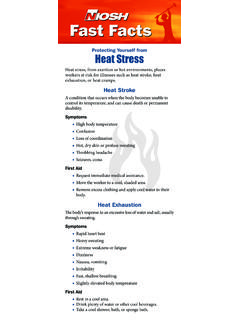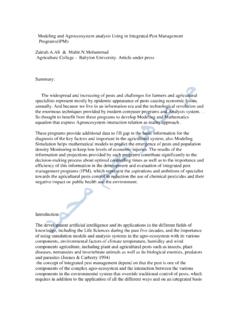Transcription of Trans Fat: The Facts
1 CS245518 National Center for Chronic Disease Prevention and Health Promotion Division of Nutrition, Physical Activity, and ObesityTrans Fat: The FactsDietary Trans FatThe Dietary Guidelines for Americans 2010 and the Institute of Medicine recommend that individuals keep Trans fatty acid consumption as low as , 2 There are two main sources of dietary Trans fatty acids ( Trans fat). Naturally occurring Trans fat is found in small amounts in the fatty parts of meat and dairy products. Artificial Trans fat comes from foods that contain partially hydrogenated oil and is formed when hydrogen is added to liquid oil turning it into solid fat.
2 Often food manufacturers use artificial Trans fat in food products because it is inexpensive and it increases the food s shelf life, stability, and texture. Foods that may contain artificial Trans fat include fried items, savory snacks (like microwave popcorn), frozen pizzas, baked goods, margarines and spreads, ready-to-use frosting, and coffee creamers. Trans fat intake has significantly decreased in the as a result of efforts to increase awareness of its health effects, Nutrition Facts label changes, industry efforts to voluntarily reformulate foods, and some state and local governments restriction of its use in restaurants and other food service outlets.
3 However, on average Americans still consume grams ( of energy) of artificial Trans fat each amount of Trans fat can vary within food categories3 Food CategoryRange of Trans Fat Per ServingMargarine and gFrozen gFrozen gSavory gWhat Are the Health Consequences of Consuming Trans Fat? Consuming Trans fat increases low-density lipoprotein (LDL, or bad ) cholesterol. This effect contributes to increased coronary heart disease and Trans fat may also have other adverse health effects like decreasing high-density lipoprotein (HDL, or good ) cholesterol. Further reducing Trans fat consumption by avoiding artificial Trans fat could prevent 10,000 20,000 heart attacks and 3,000 7,000 coronary heart disease deaths each year in the more informationCDC: FDA: Can Be Done to Reduce Artificial Trans Fat Intake?
4 Everyone can: Read the Nutrition Facts label and ingredient list to compare foods. Choose products with 0 grams Trans fat. Check the Ingredient List to see if there is any partially hydrogenated oil in the product. Because products containing less than grams of Trans fat per serving can be labeled as having 0 grams Trans fat, checking the Ingredient List is important to avoid all artificial Trans fat. When choosing foods low in Trans fat, make sure they are also low in saturated fat and cholesterol: look for foods with 5% of the Daily Value or less. Foods with 20% or more of the Daily Value of these two components are high.
5 Use monounsaturated fat (canola and olive oil) and polyunsaturated fat (soybean, corn, and sunflower oil) in recipes that call for fat. A good way to avoid Trans fat is to eat a balanced diet rich in fruits, vegetables, whole grains, lean sources of protein, and low-fat or fat-free dairy products. Ask your grocer to stock products free of partially hydrogenated oil and shortening . Talk with your favorite restaurant establishment about current use of partially hydrogenated oils or changing to a menu that is 100% free of partially hydrogenated oil and shortening . Choose restaurants that do not use partially hydrogenated oil to prepare and Cafeterias can: Change their frying and cooking oils to ones that do not contain any partially hydrogenated oil.
6 Ask suppliers to provide products that do not contain partially hydrogenated oil and are low in saturated fat. Promote partially hydrogenated oil-free and low saturated fat items on the Producers and Processors can: Continue to reformulate products to remove partially hydrogenated oil by increasing the use of mono and polyunsaturated fats as replacements. Find innovative ways to remove partially hydrogenated oil, without increasing saturated fat, from baked goods, frosting, and other products that currently contain significant amounts of Trans and Local Governments can: Increase public awareness about the use of partially hydrogenated oil in foods and cardiovascular risks of consuming Trans fat.
7 Adopt procurement guidelines regarding the sale and/or use of foods containing artificial Trans fat (partially hydrogenated oil). References1. Department of Agriculture and Department of Health and Human Services. Dietary Guidelines for Americans, 2010. 7th Edition, Washington, DC: Government Printing Office, December Institute of Medicine. Dietary Reference Intakes for Energy, Carbohydrate, Fiber, Fat, Fatty Acids, Cholesterol, Protein, and Amino Acids. National Academies Press, Washington, DC, Doell D, Folmer D, Lee H, Honigfort M, Carberry S. 2012. Updated estimate of Trans fat intake in the population.
8 Food Additives & Contaminants: Part A: Chemistry, Analysis, Control, Exposure & Risk Assessment. Available online at: Dietz WH, Scanlon, KS. 2012. Eliminating the Use of Partially Hydrogenated Oil in Food Production and Preparation. JAMA. 2012;308(2)











![KENYA G-EBIR VP-KAA [CofR 1] 3.1.29 to same …](/cache/preview/7/0/e/9/7/0/4/0/thumb-70e970408140cea493fc1d1b022df78e.jpg)





